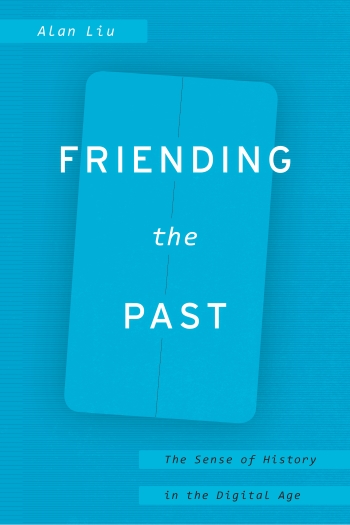| 2018 |
Friending the Past: The Sense of History in the Digital Age (Catalogue Copy, Table of Contents, Abstracts)Categories Uncategorized Uncategorized
|
Friending the Past: The Sense of History in the Digital Age. Chicago: University of Chicago Press, 2018 (forthcoming November 2018).

Catalogue Copy
Can today’s society, increasingly captivated by a constant flow of information, share a sense of history? How did our media-making forebears balance the tension between the present and the absent, the individual and the collective, the static and the dynamic—and how do our current digital networks disrupt these same balances? Can our social media, with its fleeting nature, even be considered social at all?
In Friending the Past, Alan Liu proposes fresh answers to these innovative questions of connection. He explores how we can learn from the relationship between past societies whose media forms fostered a communal and self-aware sense of history—such as prehistorical oral societies with robust storytelling cultures, or the great print works of nineteenth-century historicism—and our own instantaneous present. He concludes with a surprising look at how the sense of history exemplified in today’s JavaScript timelines compares to the temporality found in Romantic poetry.
Interlaced among these inquiries, Liu shows how extensive “network archaeologies” can be constructed as novel ways of thinking about our affiliations with time and with each other. These conceptual architectures of period and age are also always media structures, scaffolded with the outlines of what we mean by history. Thinking about our own time, Liu wonders if the digital, networked future can sustain a similar sense of history.
Table of ContentsAcknowledgmentsIntroduction (abstract)1 Friending the Past (abstract)2 Imagining the New Media Encounter (abstract)3 When Was Linearity? (abstract)4 Remembering Networks (abstract)5 Like a Sense of History (abstract)Appendix: Hypothetical Machine-Learning Workflow for Studying the Sense of History |
Book Abstract
Friending the Past asks if today’s society, increasingly captivated by up-to-the-minute information media, can have a sense of history. What is the relation between past societies whose media forms fostered a communal or self-aware sense of history—for example, storytelling in prehistorical oral societies, or the great print works of historicism in the nineteenth century—and today’s “instant” networked information society? How did the sense of history once balance between the feeling for the present and for the absent, the temporal and the social, the individual and the collective, and the static and the dynamic? And how do digital networks now change the balance? Blending the approaches of intellectual history, media studies, and digital humanities, the book proposes novel ways of thinking about the evolving sense of history. Topics include the relation between high-print historicism and social networking; narratives of “new media encounters” between societies; graphically visualized and conceptualized understandings of history; and “network archaeology” as the variant of media archaeology needed to grasp the networked texture of our contemporary feeling for history. At its close, the book calls the question: is there a sense of history in the digital, networked age? The book concludes with an example of what a digitally networked sense of history can be by examining (in a manner poised between “close reading” and “distant reading”) the code of one of today’s JavaScript “timelines” and comparing it to the experience of temporality encoded in William Wordsworth’s poetry during the era of romanticism.
Book Keywords:
digital humanities, historicism, history, information society, media, media archaeology, networks, romanticism, temporality, timelines
Chapter Abstracts
Introduction
Written fictionally in the voice of today’s “sense of history,” the introduction frames the central question of the book: in the age of digital media, digital networks, social networking, and data, can society have a sense of history comparable to that which characterized earlier eras of history and media? Speaking like a chorus in a Greek tragedy, the Sense of History speaks in character to reframe the problem as the transition from an older, interconnected circuit of meaning-making acts—”rhetoric representation interpretation”—to a later one: “communication information media.”
Chapter Keywords: communication, data, digital, information, interpretation, media, networks, representation, rhetoric, sense of history
Chapter 1: Friending the Past
Chapter 1 studies the change from prior senses of history to today’s “real time” sense of history—or instant sense of community—of social networks. How was the equivalent of a sense of history experienced, and mediated, in prehistorical oral cultures? How did print culture at the height of the history of the book, which coincided with narrative historicism in the mode of Leopold von Ranke (Historismus), alter the sense of history? And how do “Web 2.0” and social networking today yet again change the sense of history? Can today’s society “friend” past ones to imagine, and absorb, prior senses of history as a layered, enrichening texture of the present? What continuities—for example, of Internet transmissions following the routes once forced by imperial roads across conquered lands—lock the digital present to its historical past? But, also, what discontinuities allow past historicism and today’s information empire to challenge each other’s assumptions, thus enabling a more humane texture of the present mindful of the past?
Chapter Keywords: historicism, Historismus, history of the book, Leopold von Ranke, media determinism, narrative, oral culture, print culture, social networking, web 2.0
Chapter 2: Imagining the New Media Encounter
This chapter studies “narratives of new media encounter” (accounts of how individuals and societies react to the introduction of writing, radio, television, the Internet, Web 2.0, and so on) to suggest that major historical changes in the sociocultural order are mirrored in narratives of media history. Often, as in the case of Marshall McLuhan’s writings, such narratives follow a plot of progressivist media determinism—of necessary change from old media to new media—even as they also reveal the more ambivalent experience of a “contact zone” between civilizations. At once descriptive and interpretive, tales of new media encounter are a foundational form of media theory—a kind of media archaeology of media theory. They show how societies experience history as communication and information media, and communication and information media as history. They register the experience of history as media history. Finishing on the promising example of a recent collection of essays on the digital humanities, the chapter concludes by asking the critical question: what is an imaginatively enrichening rather than determinist and constraining narrative of new media encounter?
Chapter Keywords: contact zone, digital humanities, Marshall McLuhan, media archaeology, media determinism, media history, media theory, narrative, new media, old media,
Chapter 3: When Was Linearity?
Linearists, as they might be called, have staked deep claims of cultural and other value on the linear exposition of history, narrative, argument, and other forms of thought. Theorists of networks, hypertext, and other domains of today’s digital era stake equally significant claims on the nonlinear, often represented emblematically in network-style or other postlinear graphical visualizations. Indeed, they often elevate the importance of graphical knowledge in general. Informed by media history extending from oral culture and the history of the book to digital new media, this chapter asks the simplifying question: what if there never was any linearity to defend or to contest? What if the idea of linearity has always been an ideology deployed through graphical knowledge systems that are realized in graphics as the visualization of any era’s idea of authoritative linearity—for example, who gets to go to the front of a line and why—and ultimately of its sense of history? The chapter makes Wallace Stevens’s poem “The Idea of Order at Key West” (with its invocation of “meaningless plungings” yet also visualization of seas “portioned” into fixed “emblazoned zones”) a recurrent poetic touchstone of its argument–in part by using digital humanities text analysis methods to render the poem as visualizations.
Chapter Keywords: digital humanities, graphics, history of the book, ideology, linearity, media history, networks, oral culture, Wallace Stevens, visualization
Chapter 4: Remembering Networks
Chapter 4 begins on the paradigmatic instance of a hybrid print/digital work at the onset of the digital networked era—Agrippa (A Book of the Dead) by Dennis Ashbaugh, Kevin Begos, Jr., and William Gibson (1992)—to call for a method of “network archaeology” extending media archaeology. Network archaeology facilitates understanding the sense of history in our postlinear age of digital networks filled with buzzing, flitting ephemeral and dynamic artifacts making a mockery of archiving yet urgently requiring methods not just of archiving but of open, transparent archiving. Past eras created networked artifacts and systems in their own way. The chapter braids together research on web archiving, scientific workflows (data-analysis workflows facilitating reproducible research), data provenance, and digital humanities prosopography to make the case for remembering networks through new digital archiving methods. Remembering networks, it argues, is foundational for providing our networked age with its appropriate, distinctive sense of history.
Chapter Keywords: Agrippa (A Book of the Dead), media archaeology, network archaeology, networks, prosopography, provenance, reproducible research, scientific workflows, web archiving, William Gibson
Chapter 5: Like a Sense of History
This concluding chapter defines the sense of history of any era or culture as a set of parameters—ontological, epistemological, socio-historical, and others—that can be studied through a combination of close reading and digital humanities distant reading. Splitting the difference between close and distant reading, the chapter studies visualized “timelines” as a traditional mode of distant reading history (analyzing and visualizing long vistas of historical event). Then, to define the sense of history specific to the internet age, it “close reads” at the code level an influential contemporary form of history: digital timelines. Focusing on the genre of JavaScript digital timelines, which dynamically draw data from backend sources to populate the “document object model” (DOM) of web-based timelines in frontend interfaces, the chapter postulates that the digital era is characterized by its own sense of history—one attuned to the contingency of networks. Setting this contingent sense of history in relief against that of an earlier era, the chapter ends by comparing the TimelineJS Javascript timeline in particular to the time sense, and implicit timelines, in William Wordsworth’s poetry and romanticism. Code meets poetry at a junction between the internet era and the humanities.
Chapter Keywords: close reading, contingency, digital humanities, distant reading, JavaScript, networks, romanticism, sense of history, timelines, William Wordsworth
